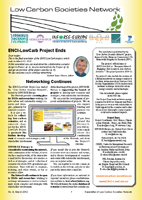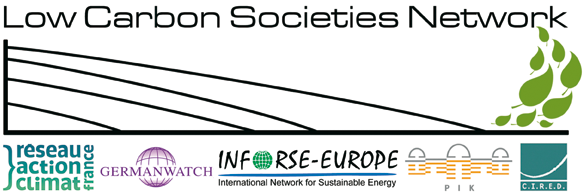 |
Stakeholder Dialogue Meetings,
Translation of Stakeholder Contributions into Modelling Parameters, and Comparison
|
Stakeholders' Dialogue Meetings
|
Stakeholders’ dialogue meetings were held in two rounds.
In Germany, during the first round of stakeholders’ meetings, the two sectoral meetings included 12 to 15 stakeholders from the transport sector and the electricity supply sector respectively. The second round of sectoral meetings was again two meeting, one for the transport sector and one for the electricity supply sector.
In France, the first round of stakeholders’ meetings consisted of three sectoral meetings on transport, electricity and the residential sector with 15 stakeholders each. The second round consisted of one joint meeting for the stakeholders from all three sectors. This joint meeting allowed cross-sectoral feedback discussions on the scenario developed with the policy measures agreed during the first round of meetings.
In the first round of stakeholders’ meetings, the ENCI-LowCarb Project was presented, including the project’s methodology. Then the main questions and challenges for the sector in question were introduced, followed by detailed presentations and discussions of the selected sub-themes. At the end, the stakeholders filled out prepared questionnaires.
The information collected at the meetings was then translated into the model’s relevant parameters and the scenario(s) was/were amended.
In the second round of the stakeholders’ meetings (in France: one joint meeting), first the revised scenarios were presented, including a description of how the feedback from the first round had been included in the new scenarios. Then the new scenarios were examined closely and the feasibility and possible social and political effects were discussed. Following this round, again the results of the stakeholder inputs were integrated into the model.
In this way the dialogues contributed to construct the scenarios around more realistic and socio-political acceptable elements, and it also provided knowledge on the strength of support and opposition that a given scenario can expect in the consulted sectors.
For both rounds of stakeholder meetings, it was important that a professional moderator was involved and that the discussion was divided into sub-themes. With these, the meetings were considered effective from all participants.

Illustrative impression of stakeholders' dialogue meeting
|
Translation of Stakeholders Contributions in Modelling Parameters
|
Between the evaluation of the contributions of stakeholders and the modelling exercise, an important step was the translation of the stakeholder visions into model parameters.
The information gathered within the sector-specific stakeholder meetings was translated by the project team into model parameters. Points of disagreement were laid open and handled by the development of scenario variants.
Here are two examples for the translation process:
France: Residential Sector – Refurbishment
One of the main obstacles for the refurbishment of houses identified by the stakeholders’ is the still predominant aversion of homeowners to refurbish their houses or apartments even if many financial incentives exist. The aversion is even higher if one is non-occupying homeowner. A barrier for owners is that the access to tax incentives and subsidies is on the condition of a high personal financial contribution. Even the access to a zero-interest loan is difficult without collaterals. The stakeholders’ recommended solutions to overcome this barrier: the creation of an obligatory refurbishment fund for jointly-owned buildings and a long-term third party financing. As these solutions cannot be integrated one-to-one into the modelling tool, alternative modelling strategies had to be developed. For instance it is possible within the Imaclim-R tool to change the specific “risk-aversion level” of the different agents (occupying and non-occupying homeowners etc.).
Germany: Sceanrio Elenments
In the German study, the outcomes of the stakeholder workshops were translated into scenario elements, called parsimonious narratives. Those scenario parameters that were judged to be realistic by the stakeholders constituted the “continuation scenario” and those that were desirable constituted the “Paradigm shift scenario”. The “Paradigm shift + scenario” included additional elements that were not widely accepted by the stakeholders.
In the following table are listed some of the most important differences between the three scenarios

Table with important differences between the three scenarios developed for Germany. FT is freight transport, PT is public transport, MS is modal split of transport , REG is renewable energy generation, PP is power plants, CCS is Carbon Capture and Storage
|
Comparing the French and German Stakeholder Processes
|
The processes of stakeholder involvement in Germany and France were in many ways parallel, but there were also differences mainly induced by the different nature of the modelling tools. The formal differences were that there were more sectors involved in the French stakeholder process (housing was included) and that the last round was made as one joint cross-sectoral meeting in France.
A remarkable difference between the German and French process was that the German scenario reaches a higher reduction of emissions (-85% compared to -68% in France, both relative to emissions in 1990). One way of explaining this is by the choice of different approaches for the decision on the emission reductions: In the German study a fixed emission budget for the whole period was used. So the modelling tool was constrained to an 85% reduction. Stakeholders had no influence on this target. In France no emission target in 2050 was fixed but the stakeholders decided on policy measures and technology choices that were acceptable following to their judgment. The representation of all measures judges acceptable by the stakeholders led to a reduction about 68%. A supplementary explanation of the difference in relative emission reductions is the difference in per capita emissions in 1990 (7 tons in France versus 12 tons in Germany, see 3.1).
Another difference was that the German stakeholders reflected both on the likeliness and desirability of a number of developments, while in French stakeholders only commented on the acceptability of measures. In the German study this led to the definition of different scenarios: the “continuation” scenario and the “paradigm shift” scenario, resembling the developments in the electricity and transport sector that stakeholders judge as likely and desirable, respectively.
|
- Article/Report: "Social Acceptance in Quantitative Low Carbon Scenarios", Eva Schmid et al, October 2011.  Report, 2012 (pp. 25, pdf, 0.47 MB) Report, 2012 (pp. 25, pdf, 0.47 MB)
- Fact Sheet: "Lessons Learned from Researcher - NGO cooperation on development of lowcarbon scenarios",  (Lessons Learned 2-page fact-sheet, 0.2 MB) (Lessons Learned 2-page fact-sheet, 0.2 MB)
- Fact Sheet: "Stakeholders Contribute to the Socio-Political Acceptance of Low-Carbon Scenarios." English version  (2-page fact-sheet, 0.38 MB) (2-page fact-sheet, 0.38 MB)
- Poster: "Social Acceptance of Low Carbon Scenarios: Step 3. Stakeholder Involvement"  (pdf file 0.3 MB) (pdf file 0.3 MB) |
 |
Return to Contents:
Collaborative Scenario Creation Processes for Germany and France. |
|
News
The Project is ended in 2012,
but the collection of scenarios
is continued being updated:
Check out the New European
CLEVER Scenario, June 2023:
• Regional Scenarios
• National Scenarios
• Global Scenarios
News from Project (2009-12)

• March 15, 2012
Paris, France
Final Conference
Proceedings
•  March, 2012 March, 2012
Newsletter # 9
|


 March, 2012
March, 2012


